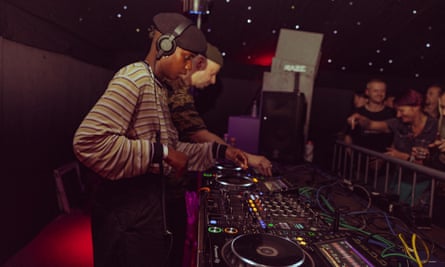The sounds swirling around Sheffield Cathedral rumble with a brooding and malevolent air. Drones whirr like helicopter blades and icy electronics pierce the air as Blackhaine delivers his inimitable Lancastrian social-realist avant-rap. His guttural screams are so intense you wonder if the stained glass windows could shatter. He and his crew even manage to force a circle pit among the audience, in the exact place that worshippers will be sitting silently for afternoon prayers the following day.
It’s a remarkably intense first act to see at No Bounds, a festival now in its sixth year that has already become an unmissable date in the dance music calendar. Operating primarily out of Hope Works, an old first world war gun barrel factory, the festival has stretched even further across the city this year, from opening up a still-functioning electricity substation in a towering brutalist building, to linking up with numerous DIY and independent venues across the city.
Its musical remit is just as wide. Blawan’s punishing live set follows Blackhaine’s in shaking the cathedral to its very foundations. Over in Hope Works, Rian Treanor and the Acholi fiddle player Ocen James bring Ugandan music into the heart of industrial Sheffield. It’s a joyous and spirited set that merges contemporary dance music with traditional east African sounds to wonderful effect. Later on, Sherelle and Kode9’s back-to-back set is a heady plunge into wobbly footwork and slabs of dense jungle. Sheffield’s own 96 Back pulls off a hugely varied and masterful set that takes in rib-tickling bass, ethereal IDM, deep synth funk and just about anything else in between. It’s all delivered in an intimate and charming environment as he repeatedly stops the music to casually introduce tracks over the mic, like some kind of avant-bingo caller.

No Bounds also offers a broad array of installations: inside the vast and eerie substation, Amy Carter curates Mythical Living Data by Noemie Soula, a striking audiovisual piece that imagines how a polluted environment may alter our future DNA, showing imagery of mutating organs. Elsewhere, Lise Autogena and Joshua Portway fill up a room with oil at the same rate as the oceans are rising, while David Cotterrell explores the role of micro simulation in our lives via an immersive dome with hypnotic visuals, complete with an algorithmically generated sound installation by Shelly Knotts.
The festival ends where it started, back in the cathedral, with Rotherham producer Mark Fell curating the work of Beatrice Dillon, Nakul Krishnamurthy and Morton Feldman, all performed by the Explore Ensemble. It is a performance of such quiet restraint and subtlety that the music almost disappears into the room itself.
The end result is a festival that explores the interaction between music, physical space and Sheffield itself. It succeeds in tapping into the history, culture and heritage of the city and expanding on it by filling it with some of the most exploratory, innovative and ceaselessly creative electronic music in the world.




